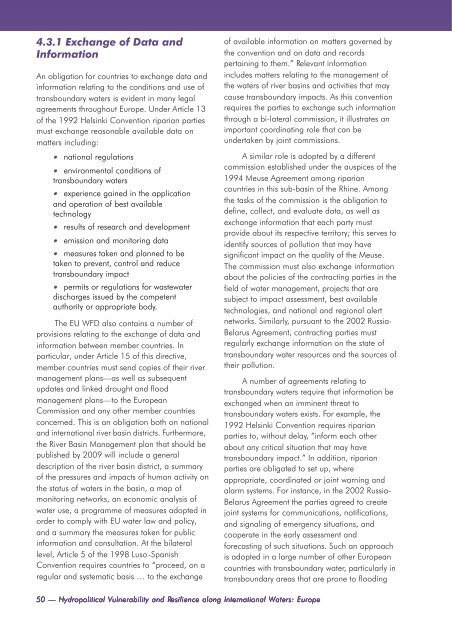Europe - UNEP
Europe - UNEP
Europe - UNEP
Create successful ePaper yourself
Turn your PDF publications into a flip-book with our unique Google optimized e-Paper software.
4.3.1 Exchange of Data and<br />
Information<br />
An obligation for countries to exchange data and<br />
information relating to the conditions and use of<br />
transboundary waters is evident in many legal<br />
agreements throughout <strong>Europe</strong>. Under Article 13<br />
of the 1992 Helsinki Convention riparian parties<br />
must exchange reasonable available data on<br />
matters including:<br />
• national regulations<br />
• environmental conditions of<br />
transboundary waters<br />
• experience gained in the application<br />
and operation of best available<br />
technology<br />
• results of research and development<br />
• emission and monitoring data<br />
• measures taken and planned to be<br />
taken to prevent, control and reduce<br />
transboundary impact<br />
• permits or regulations for wastewater<br />
discharges issued by the competent<br />
authority or appropriate body.<br />
The EU WFD also contains a number of<br />
provisions relating to the exchange of data and<br />
information between member countries. In<br />
particular, under Article 15 of this directive,<br />
member countries must send copies of their river<br />
management plans—as well as subsequent<br />
updates and linked drought and flood<br />
management plans—to the <strong>Europe</strong>an<br />
Commission and any other member countries<br />
concerned. This is an obligation both on national<br />
and international river basin districts. Furthermore,<br />
the River Basin Management plan that should be<br />
published by 2009 will include a general<br />
description of the river basin district, a summary<br />
of the pressures and impacts of human activity on<br />
the status of waters in the basin, a map of<br />
monitoring networks, an economic analysis of<br />
water use, a programme of measures adopted in<br />
order to comply with EU water law and policy,<br />
and a summary the measures taken for public<br />
information and consultation. At the bilateral<br />
level, Article 5 of the 1998 Luso-Spanish<br />
Convention requires countries to “proceed, on a<br />
regular and systematic basis … to the exchange<br />
of available information on matters governed by<br />
the convention and on data and records<br />
pertaining to them.” Relevant information<br />
includes matters relating to the management of<br />
the waters of river basins and activities that may<br />
cause transboundary impacts. As this convention<br />
requires the parties to exchange such information<br />
through a bi-lateral commission, it illustrates an<br />
important coordinating role that can be<br />
undertaken by joint commissions.<br />
A similar role is adopted by a different<br />
commission established under the auspices of the<br />
1994 Meuse Agreement among riparian<br />
countries in this sub-basin of the Rhine. Among<br />
the tasks of the commission is the obligation to<br />
define, collect, and evaluate data, as well as<br />
exchange information that each party must<br />
provide about its respective territory; this serves to<br />
identify sources of pollution that may have<br />
significant impact on the quality of the Meuse.<br />
The commission must also exchange information<br />
about the policies of the contracting parties in the<br />
field of water management, projects that are<br />
subject to impact assessment, best available<br />
technologies, and national and regional alert<br />
networks. Similarly, pursuant to the 2002 Russia-<br />
Belarus Agreement, contracting parties must<br />
regularly exchange information on the state of<br />
transboundary water resources and the sources of<br />
their pollution.<br />
A number of agreements relating to<br />
transboundary waters require that information be<br />
exchanged when an imminent threat to<br />
transboundary waters exists. For example, the<br />
1992 Helsinki Convention requires riparian<br />
parties to, without delay, “inform each other<br />
about any critical situation that may have<br />
transboundary impact.” In addition, riparian<br />
parties are obligated to set up, where<br />
appropriate, coordinated or joint warning and<br />
alarm systems. For instance, in the 2002 Russia-<br />
Belarus Agreement the parties agreed to create<br />
joint systems for communications, notifications,<br />
and signaling of emergency situations, and<br />
cooperate in the early assessment and<br />
forecasting of such situations. Such an approach<br />
is adopted in a large number of other <strong>Europe</strong>an<br />
countries with transboundary water, particularly in<br />
transboundary areas that are prone to flooding<br />
50 — Hydropolitical Vulnerability and Resilience along International Waters: <strong>Europe</strong>
















